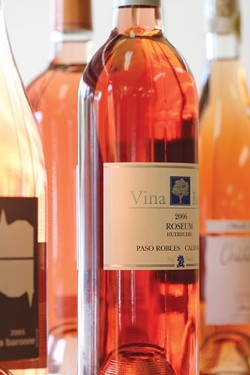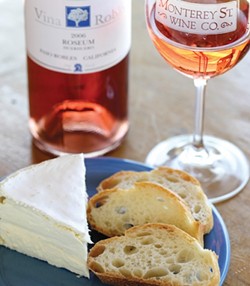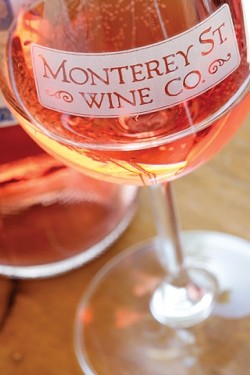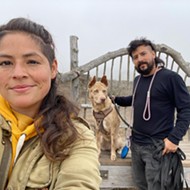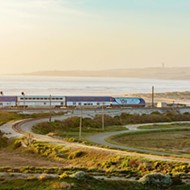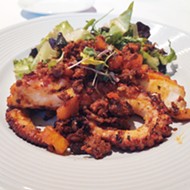[{
"name": "Ad - Medium Rectangle CC01 - 300x250",
"id": "AdMediumRectangleCC01300x250",
"class": "inlineCenter",
"insertPoint": "8",
"component": "2963441",
"requiredCountToDisplay": "12"
},{
"name": "Ad - Medium Rectangle LC01 - 300x250",
"id": "AdMediumRectangleCC01300x250",
"class": "inlineCenter",
"insertPoint": "18",
"component": "2963441",
"requiredCountToDisplay": "22"
},{
"name": "Ad - Medium Rectangle LC09 - 300x250",
"id": "AdMediumRectangleLC09300x250",
"class": "inlineCenter",
"insertPoint": "28",
"component": "3252660",
"requiredCountToDisplay": "32"
}]
With the warm days of summer upon us, my taste in wine quite naturally turns toward dry Roses. They sate my thirst for cool refreshment. Honestly, I've loved these delicious quaffers ever since my first sip when I was tasting coordinator for Wine Spectator magazine in San Francisco. It was a 1990 Vin du Mistral Grenache Rose by Joseph Phelps, a visionary vintner who was the first in California to plant and produce Rhone varieties. That extraordinary wine was impressive enough to stifle my embarrassment over drinking something pink.
# That's been a problem for dry Rose it's been denigrated because it looks like White Zinfandel. But savvy wine lovers know that fine Rose provides the intriguing layers of flavors we expect from any great bottle of wine. California Roses have changed since the early '90s and now they're better than ever. Numerous newspapers and lifestyle magazines report that Rose sales are booming as Americans become more sophisticated in their taste for fine wines.
At Monterey St. Wine Co. in San Luis Obispo, co-owner John Stipicevich said he's seeing more interest from consumers.
"The Roses that come out in early spring tend to grab people's attention and they stay with it," Stipicevich explained, noting that it's easier to sell Rose when people can sample it at his tasting bar, where he usually has some available. "I always encourage people to broaden their horizons, to step outside their comfort zone and try something new."
Sales may be booming in L.A. and San Francisco, but Central Coast consumers need more incentive than high ratings to persuade them to try Rose. At Morro Bay Wine Seller, co-owner John Nordhus admitted that consumers haven't come in looking for it, but he usually has one available to try at his tasting bar. And Nordhus knows how to convince skeptics to try something new: Don't give them any choice.
"I don't let them try anything else until they taste the Rose I'm pouring," Nordhus said with a chuckle. "Invariably they say, 'Hey, that's pretty good! I'll take some.'"
Nordhus uses his website, www.morrobaywineseller.com, to question prejudice from "normal consumers" about pink wines. Noting the Central Coast's reputation for big, bold, concentrated Syrah, Grenache, and Pinot Noir, he points out that they represent this region's identity: "We're the veritable treasure trove of the best." That's true whether those varietals are made red or pink.
After the aforementioned Phelps' Rose was evaluated by Wine Spectator's editors, I took the remainder to one of my favorite SF
# foodie events, called "ala carte ala park." Held annually in Golden Gate Park, it featured dozens of great restaurants and wineries. There I discovered that the foods I sampled tasted even better with that amazing Rose. It seemed a revelation, but the French of course have enjoyed Rose during summer for decades, if not centuries.Most early California Roses were produced saignee, a French term referring to the removal of juice from a vat of wine considered light-bodied. Also called free-run, it was usually discarded. Removing free-run juice concentrates the flavors of the wine from which it came. No surprise, the flavorful juice was usually worth saving, so winemakers fermented it as they would white wine, bottling it for release in spring. As Roses have become more popular, more wineries began producing them, and there's an array of good local ones to choose from.
Many Roses are produced saignee method, but winemakers focused on premium-quality Roses choose specific varieties and harvest them earlier than grapes intended for still red wines. Winemaker Louisa Sawyer Lindquist of Verdad in Santa Maria Valley is one of those artisanal producers with a focus on Spanish varietals. Although Lindquist's Rose blend usually featured Tempranillo, she excluded it in her 2006 blend.
"I thought the Tempranillo was too assertive in the blending trials, and it goes against my philosophy of picking early," she explained. "I strive for lower alcohol with good acidity."
Admitting that her husband and partner Bob Lindquist (famous for his outstanding Qupe wines) was surprised she dropped the Tempranillo, she added: "I'm trying to make the best wine I can." The result, composed of 85 percent Grenache and 15 percent Mourvedre, has earned high scores from wine critics.
# With his fourth vintage of Syrah Rose, winemaker Matt Ortman of Ortman Family Vineyards also made a significant change. His first Roses were saignee method, but during the '06 harvest he picked the Syrah intended for his Rose two weeks early to capture bright acidity, and cold soaked the must three days for better color. He always adds some Viognier to give the Rose complex aromatic qualities.
"Our Rose is really nice with salad dressed in vinaigrette and cranberries, which can really throw a white or red wine off," said Ortman, who's still offering this impressive wine at his tasting room in Edna Valley. "Rose is a fun wine that's a celebration of spring and summer."
At first, I preferred Roses made from Rhone varietals like Syrah, Counoise, and Grenache, but they can be made from anything, including Cabernet Sauvignon or Zinfandel. Lately, many Roses of Pinot Noir strike a chord of pleasure for me. Among my favorite local producers consistently producing outstanding Roses are Beckmen, Domaine Alfred, Fiddlehead, Flying Cloud, Ortman, Tablas Creek, Vina Robles, and Verdad.
Like my experience at that San Francisco picnic, I still find that everything from main course salads to boldly flavored barbecued ribs tastes great with the refreshing acidity of a good Rose. Understandably, people think of it as the summer refresher, but I say forget boundaries a good Rose is delightful year round.
SIDEBAR: Outstanding in the field
What better way to enjoy the treats grown in local farms than sitting down at a table in the field where you're surrounded by the colorful bounty you're about to indulge in? You'll enjoy it more knowing you're supporting the Food Bank Coalition of SLO County. With the event now in its third year, the Harvest Foundation sponsors bring together local chefs, winemakers, and foodies for an informal reception and dinner at the organic Gold Ridge Farm located at the base of Hollister Peak.
Without planning ahead, the chefs prepare a feast from the incredible tomatoes, squash, beans, and fruit freshly plucked from the fields just before preparing them. Several local wineries will expertly pair their best wines with each course. Dress is strictly casual, so forget the spiked heels for more comfortable shoes, hats, and a wrap in case it gets cool at sunset. You can register online and get more information about raising money for hunger relief at www.SLOFoodbank.org or by calling 238-4664. Tickets, at $150 (tax deductible) per person, are limited and you must reserve in advance.
Harvest Rustica 3 A Feast in the Field is 3 to 7 p.m. on Sept. 1.
You can reach New Time's Cuisine columnist at [email protected].

